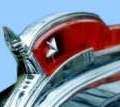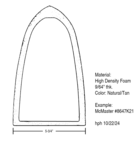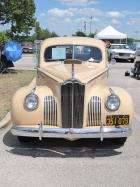|
Re: What SINGLE factor MOST contributed to the demise of Packard?
|
||||
|---|---|---|---|---|
|
Forum Ambassador

|
They would have gone broke in a year selling a handful of custom built $7000 cars, same as Pierce Arrow, Marmon and Stutz.
Rusty, I appreciate your thoughts but perhaps you didn't quite note all that I said, they would still have sold 50,000 120s, and perhaps another 20,000 120s if the 110 weren't available. Though the 120 which they would have retained wasn't quite in the luxury class, the 110 was one step too far downscale. Perhaps Fred Kanter is more on target when he says the biggest single factor contributing to Packard's demise was TIME.
Posted on: 2013/10/25 7:42
|
|||
|
||||
|
Re: What SINGLE factor MOST contributed to the demise of Packard?
|
||||
|---|---|---|---|---|
|
Home away from home

|
Hi
Yes, indeed, the 110 was one step too far down into a competitve meatgrinder price segment. The 120 also suffered from the 110 syphoning off sales for those who came into the dealership attracted primarily by low price. To take nothing away from the 110, if anything, it was too much Packard for the price, so much so that justifying the additonal for a 120 was difficult for many. While the 110 provided volume, it did so at lower unit profit. Better they should have positioned the 120 versus Buick Special at $1,000 then added a larger engine version in the Buick Century mode at $1,200. The Century was a high profile car for Buick, did much to give them a hot car image. It did have one of the best power-to-weight ratios at the time. On the practice of comparing the current luxury buyers outlook overlaid on that pre-war period, I think we misunderstand the major difference. The buyer outlook then was very stratified, with quite strict ideas about size, features, power, cylinder count and maker. The acceptance of small, four cylinder fleet models, luxury four, six and V-8 sedans, sporty six coupes and large twelve flagships sedans all from the same maker would be very much a stretch for those pre-war buyers. Each classification or covering of proximate segments was the province of a carmaker but to stretch to cover all would have been unheard of and rejected. Steve
Posted on: 2013/10/25 8:07
|
|||
|
||||
|
Re: What SINGLE factor MOST contributed to the demise of Packard?
|
||||
|---|---|---|---|---|
|
Home away from home
|
Quote:
After all is said, and said, and said... that's the bottom line.
Posted on: 2013/10/25 9:09
|
|||
|
||||
|
Re: What SINGLE factor MOST contributed to the demise of Packard?
|
||||
|---|---|---|---|---|
|
Home away from home

|
I think the 110 was too good a car to knock down. They had a giant plant and needed to use it. When the heavier Clipper came out the Six was done.
If they had concentrated on the low price slot they might have gotten enough volume to push Ford into bankruptcy after the war. It was Max Gilman's plan to sell classy little cars that make the average guy feel good about himself. Today the same problem exists. The bottom of the car market is wide open and pretty soon the Chinese or the Indians are going to bring out a nice little horseless buggy that shakes up the domestic floor plan. Overseas you can't pull up to a traffic light without being behind a Nissan Sunny. Heck, the other day I was at a meeting and they were talking about how Nissans can go 400,000 miles.
Posted on: 2013/10/25 11:17
|
|||
|
||||
|
Re: What SINGLE factor MOST contributed to the demise of Packard?
|
||||
|---|---|---|---|---|
|
Home away from home

|
Quote:
... BMW V12's from the mid 1980's are almost worthless in OZ, because the computers are unobtainum and they are unrepairable. A 1976 6.9 Benz which cost me $80,000 is also worthless now ... That have been two. Now to the other hundred models. Or two hundred? I don't believe that worthlessness is the chracteristic feature of the products of these two global industry leaders. Quote: ... and you can pay around 5,000 for a good one ... Well-preserved 1970s Mercedes Benz 6.9 up for sale in Germany: $77,108.00 $68,832.00 $81,385.00 <iframe width="500" height="281" src="//www.youtube.com/embed/_IyLk30H4BE?rel=0" frameborder="0" allowfullscreen></iframe>
Posted on: 2013/10/25 12:32
|
|||
|
The story of ZIS-110, ZIS-115, ZIL-111 & Chaika GAZ-13 on www.guscha.de
|
||||
|
||||
|
Re: What SINGLE factor MOST contributed to the demise of Packard?
|
||||
|---|---|---|---|---|
|
Home away from home

|
On an odd side note, I was listening to the radio when driving home today. Three DJs were discussing a certain rap star who was known for using brand names in his lyrics. They tried to guess which brands got the most frequent mention.
Turns out Mercedes was #1 followed by Lexus. Nike was well up on the list. Porsche appeared farther down. So, it appears that making cheap cars has not ruined Mercedes reputation. I doubt he was singing the praises of 4 cylinder taxicabs. No doubt he was referring to the luxury models. I also have a hard time believing that people bought Packards in the thirties and forties, when they were making six cylinder models, but stopped buying them in the fifties when they had gone upmarket and made 8 cylinder cars exclusively - because they suddenly realized that Packard had made six cylinder cars 15 or 20 years earlier, and therefore the new models were not worth buying. I find it much easier to believe that they did not buy Packards in the fifties because they compared them with other makes in the same price range, and found them wanting. One other factor that has not been mentioned. Fifties Packards had a drab, cheap looking instrument panel more suited to a car in the Ford price bracket. Furthermore they used the same one in all models, even the most expensive. And they used it for several years. This may look like a small thing but I wonder. The instrument panel is one thing the driver sees every time he gets in the car. Other makers went to a lot of trouble to make theirs attractive, or at least interesting. To give the more expensive models a different, more expensive look. And to change the design every year. I don't think they did it for fun. I think they did it because it was a good way to differentiate the cars and it did not cost much money. In other words they considered it money well spent for the impact it had on the customer's perception of value and therefore, on sales. I did not think this up on my own. I saw an interview with a Ford stylist who did not think much of Robert McNamara as CEO of Ford, who felt he knew nothing about cars and his ideas were worthless. One of these worthless ideas was to save money by using the same instrument panel in all Ford, Mercury and Lincoln cars. The stylist considered this so idiotic he just shook his head. Meanwhile Packard was doing it.
Posted on: 2013/10/26 9:28
|
|||
|
||||
|
Re: What SINGLE factor MOST contributed to the demise of Packard?
|
||||
|---|---|---|---|---|
|
Home away from home

|
There were other factors that had nothing to do with Packard. One was the ding dong battle for sales supremacy between Ford and Chevrolet.
Henry Ford II was determined to take the sales crown back for Ford. To this end they did everything they could think of to push cars on their dealers and capture market share at all costs. This led to the rise of the "system house", a type of car dealership ran along the lines of a clip joint. Their design was to sell cars if they had to lie, cheat, swindle, or intimidate the customer. These high pressure sales rackets got so bad the government had to step in and pass new consumer protection laws including the price sticker or Mulroney sticker that still appears in car windows. The big winners were the big GM and Ford dealers who could afford saturation advertising campaigns, teams of salesmen and closers, and who could pump out car sales by the hundreds. The big loser was the independents. They were generally smaller home town dealers who were caught flat footed by this new carny style of sales. By the time they figured it out it was too late.
Posted on: 2013/10/26 9:38
|
|||
|
||||
|
Re: What SINGLE factor MOST contributed to the demise of Packard?
|
||||
|---|---|---|---|---|
|
Home away from home

|
Quote:
They did sell 50,000 120s. 50,100 to be exact, and 65,400 sixes. This was in 1937, first year of the six. The previous year they sold 55,420 120s. So it appears the six cost them 5000 120 sales but garnered 60,000 new customers. At the same time Super 8 sales went from 1330 to 5793 and V12 sales went from 682 to 1300. So if the 110 poisoned sales of the expensive models, it was a slow acting poison. 1937 was a banner year, next year sales dropped by half across the board. There is no obvious drop off in the heavy models, at least no greater than the cheap models. In 1939 sales dropped slightly more, except for Super 8 which increased sales by almost half. Looking further, in the forties six cylinder sales dropped off.In 1942 they actually sold less Clipper 6 models than they did the cheapest 8. In 1946 they made more 6s than 8s, but the next year sales of the 6 dropped away down and after 1947, no more 6 cylinder cars. In the meantime the most expensive V12 and Super Eight models sold about the same in proportion, right along. I don't see any sign that the sixes killed the sales of the most expensive models. What I do see is that the six was sensationally popular in the depression, and later in the forties it lost ground to the eight cylinder cars and was finally dropped due to lack of interest and lack of sales. So, it appears that the six didn't kill the deluxe models. It was the other way around. I should include a link showing where I got these sales figures. They come from a web site with spec sheets on all the old cars. carnut.com/specs/specs.html See for yourself and compare sales of the different models and years. I don't think there is any question that the six cylinder models sold well and made lots of profits for Packard. They also made good use of their factory facilities and therefore, brought down the cost of building the more expensive cars. On the principle that the more you mass produce of something, the more you bring down the unit cost. The question is, did the six cylinder car ruin Packard's reputation and drive away the tycoons and millionaires who bought the Super 8 and V12 models? The answer appears to be no. These heavy models always sold in small numbers and they continued to sell in similar numbers in proportion to total Packard sales. In other words they went up and down with the economy and with car sales generally. They did not nose dive when the 110 hit the show rooms. If anything, sales of the most expensive models went up when they dropped the six, but this was more a function of the prosperous post war economy. Another question is what else were they going to buy? With Pierce Arrow, Marmon, Stutz, Duesenberg and other luxury makes gone and Lincoln gone down market with the Zephyr anyone in the market for a true luxury car had a choice of Packard or Cadillac. If a potential Packard buyer was irked by the fact that his grocer drove a Packard 6, he could be equally put off by the fact that his bookie drove a Cadillac.
Posted on: 2013/10/26 10:17
|
|||
|
||||
|
Re: What SINGLE factor MOST contributed to the demise of Packard?
|
||||
|---|---|---|---|---|
|
Home away from home

|
For your amusement here is a comparison of Packard and its rivals in 1954, because I happen to have a chart in a 1954 Science and Mechanics magazine.
Packard Clipper $2544 122"wb, 150HP straight eight. Someone in the market for a car in that price bracket could also look at - Buick Super $2466 127"wb 177HP V8 Chrysler Windsor Deluxe $2350 125.5'wb 116HP 6 DeSoto Firedome $2453 125.5"wb 170HP V8 Hudson Super Wasp $2465 120"wb 140HP 6 Nash Ambassador Super $2412 121"wb 130HP 6 Oldsmobile 98 $2551 126"wb 185HP V8 Studebaker Land Cruiser $2438 120.5"wb 120HP V8 Moving up to the next rung in the Packard ladder - Clipper Deluxe $2695 122"wb 165HP 8 Compares to - Hudson Hornet $2768 123.8" wb 160HP 6 Packard Cavalier $3344 127"wb 185HP 8 Compares to - Buick Roadmaster $2971 127"wb 200HP V8 Chrysler New Yorker $2965 125.5"wb 195HP V8 New Yorker Deluxe $3155 125.5"wb 235HP V8 Lincoln Cosmopolitan $3226 123"wb 205HP V8 Capri $3402 123"wb 205HP V8 Packard Patrician $3890 127"wb 212HP 8 Packard Pacific Hardtop $3827 122"wb 185HP 8 Packard convertible $3935 122"wb 185HP Cadillac Series 62 $3932 129"wb 230HP V8 Cadillac Series 60 $4683 133"wb 230Hp V8 Chrysler Imperial $3925 133.5"wb 235HP V8 Packard Caribbean $6100 122"wb 185HP 8 Cadillac Eldorado $4738 129"wb 230HP V8 Packard Custom (LWB limo) $6900 149"wb 212HP 8 Cadillac Series 75 (LWB limo) $5874 149.8"wb 230HP V8 Chrysler Imperial Crown (LWB limo) $6406 145.5"wb 235HP V8 All cars base model 4 door sedans, no extras. Except where otherwise noted. As you can see Packard had some strong competition that year, most comparable cars selling for a few bucks less than Packard. And when you look at the out and out luxury class,Packard's selection is rather thin.
Posted on: 2013/10/26 11:45
|
|||
|
||||







